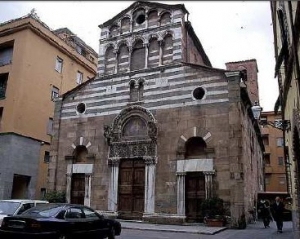
Information
Address:
Corte del Biancone 5, 55100 Lucca
Foundation:
XII-XIII century
District/Location:
Lucca
District:
Piana di Lucca


The Church of S. Giusto, built between the 12th and 13th century, was decontextualised by the demolishment in 1932 of all the buildings that surrounded it. The interior has an array of baroque forms.
Corte del Biancone, 5, 55100 Lucca LU
In old times called "S. Giusto de arcu" due to its vicinity to the Canto d´Arco, it is first mentioned in a document from 1040 that describes it as near the old Royal Mint and Palace (or rather the old Longobard administrative headquarters). The present building dates to the 12th and 13th century, but the upper part of the façade was still under construction in 1323. The brick bell tower is a 14th century addition. In 1639, the church was granted to the Seminary of S. Martino.
The structure of central nave and two side aisles with apse is built in large stone blocks and characterised by an orientation contrary to liturgical norms that placed the apse to the east. The façade, decorated like many other churches in the Lucca area with the two-colour pattern accentuated in the building’s upper part, is embellished by the central portal, one of the most interesting examples of those produced by the Guidetto studio. This features two twisting telamons supporting the lions jutting out to the sides of the lunette and two classical mascarons supporting the frame of the internal lunette.
The church interior was given an organically baroque appearance in the 17th century. These alterations, between 1661 and 1662, were promoted by the priest Ottavio Bianchi to celebrate the taking up of residence of the confraternity of the Madonna dei Miracoli, and entrusted to the architect Giovanni Maria Padredio of the Borromini tradition.
Most of the church’s paintings date to around this renovation phase, including the Nativity by Giovanni Marracci, the Virgin Mary with Saints Francesco and Apollonia by Girolamo Scaglia and Papa Gregorio Magno, thought to be by Paolo Biancucci.
Seat of the University of the Mercanti before passing to S. Cristoforo, this church went on to host the Society of the Madonna dei Miracoli, whose image can now be seen at the left altar, having been at the high altar from at least 1679 and removed to make space for a fake grotto with the Virgin Mary of Lourdes, greatly venerated from the early 20th century.
The structure of central nave and two side aisles with apse is built in large stone blocks and characterised by an orientation contrary to liturgical norms that placed the apse to the east. The façade, decorated like many other churches in the Lucca area with the two-colour pattern accentuated in the building’s upper part, is embellished by the central portal, one of the most interesting examples of those produced by the Guidetto studio. This features two twisting telamons supporting the lions jutting out to the sides of the lunette and two classical mascarons supporting the frame of the internal lunette.
The church interior was given an organically baroque appearance in the 17th century. These alterations, between 1661 and 1662, were promoted by the priest Ottavio Bianchi to celebrate the taking up of residence of the confraternity of the Madonna dei Miracoli, and entrusted to the architect Giovanni Maria Padredio of the Borromini tradition.
Most of the church’s paintings date to around this renovation phase, including the Nativity by Giovanni Marracci, the Virgin Mary with Saints Francesco and Apollonia by Girolamo Scaglia and Papa Gregorio Magno, thought to be by Paolo Biancucci.
Seat of the University of the Mercanti before passing to S. Cristoforo, this church went on to host the Society of the Madonna dei Miracoli, whose image can now be seen at the left altar, having been at the high altar from at least 1679 and removed to make space for a fake grotto with the Virgin Mary of Lourdes, greatly venerated from the early 20th century.
Scopri altre attrazioni vicino a Saint Giusto
See allYou may also like..
See allFind more
0











